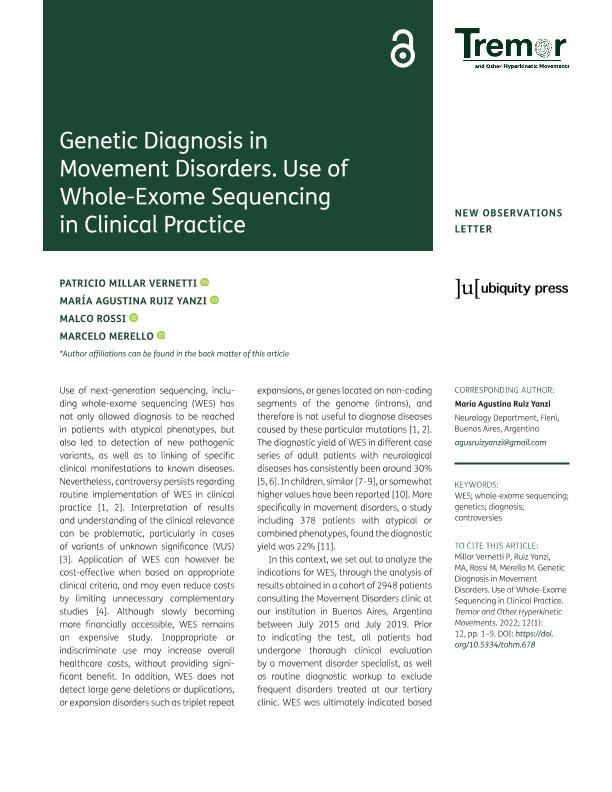Mostrar el registro sencillo del ítem
dc.contributor.author
Millar Vernetti, Patricio Alejandro

dc.contributor.author
Ruiz Yanzi, María Agustina
dc.contributor.author
Rossi, Malco Damian

dc.contributor.author
Merello, Marcelo Jorge

dc.date.available
2023-10-30T14:21:34Z
dc.date.issued
2022-04
dc.identifier.citation
Millar Vernetti, Patricio Alejandro; Ruiz Yanzi, María Agustina; Rossi, Malco Damian; Merello, Marcelo Jorge; Genetic Diagnosis in Movement Disorders. Use of Whole-Exome Sequencing in Clinical Practice; Ubiquity Press; Tremor and Other Hyperkinetic Movements; 12; 1; 4-2022; 1-9
dc.identifier.uri
http://hdl.handle.net/11336/216393
dc.description.abstract
Use of next-generation sequencing, including whole-exome sequencing (WES) has not only allowed diagnosis to be reached in patients with atypical phenotypes, but also led to detection of new pathogenic variants, as well as to linking of specific clinical manifestations to known diseases. Nevertheless, controversy persists regarding routine implementation of WES in clinical practice [1, 2]. Interpretation of results and understanding of the clinical relevance can be problematic, particularly in cases of variants of unknown significance (VUS) [3]. Application of WES can however be cost-effective when based on appropriate clinical criteria, and may even reduce costs by limiting unnecessary complementary studies [4]. Although slowly becoming more financially accessible, WES remains an expensive study. Inappropriate or indiscriminate use may increase overall healthcare costs, without providing significant benefit. In addition, WES does not detect large gene deletions or duplications, or expansion disorders such as triplet repeat expansions, or genes located on non-coding segments of the genome (introns), and therefore is not useful to diagnose diseases caused by these particular mutations [1, 2]. The diagnostic yield of WES in different case series of adult patients with neurological diseases has consistently been around 30% [5, 6]. In children, similar [7–9], or somewhat higher values have been reported [10]. More specifically in movement disorders, a study including 378 patients with atypical or combined phenotypes, found the diagnostic yield was 22% [11].
dc.format
application/pdf
dc.language.iso
eng
dc.publisher
Ubiquity Press
dc.rights
info:eu-repo/semantics/openAccess
dc.rights.uri
https://creativecommons.org/licenses/by/2.5/ar/
dc.subject
CONTROVERSIES
dc.subject
DIAGNOSIS
dc.subject
GENETICS
dc.subject
WES
dc.subject
WHOLE-EXOME SEQUENCING
dc.subject.classification
Neurología Clínica

dc.subject.classification
Medicina Clínica

dc.subject.classification
CIENCIAS MÉDICAS Y DE LA SALUD

dc.title
Genetic Diagnosis in Movement Disorders. Use of Whole-Exome Sequencing in Clinical Practice
dc.type
info:eu-repo/semantics/article
dc.type
info:ar-repo/semantics/artículo
dc.type
info:eu-repo/semantics/publishedVersion
dc.date.updated
2023-10-27T16:11:33Z
dc.identifier.eissn
2160-8288
dc.journal.volume
12
dc.journal.number
1
dc.journal.pagination
1-9
dc.journal.pais
Reino Unido

dc.description.fil
Fil: Millar Vernetti, Patricio Alejandro. Fundación para la Lucha contra las Enfermedades Neurológicas de la Infancia; Argentina
dc.description.fil
Fil: Ruiz Yanzi, María Agustina. Fundación para la Lucha contra las Enfermedades Neurológicas de la Infancia; Argentina
dc.description.fil
Fil: Rossi, Malco Damian. Consejo Nacional de Investigaciones Científicas y Técnicas; Argentina. Fundación para la Lucha contra las Enfermedades Neurológicas de la Infancia; Argentina
dc.description.fil
Fil: Merello, Marcelo Jorge. Consejo Nacional de Investigaciones Científicas y Técnicas; Argentina. Fundación para la Lucha contra las Enfermedades Neurológicas de la Infancia; Argentina
dc.journal.title
Tremor and Other Hyperkinetic Movements
dc.relation.alternativeid
info:eu-repo/semantics/altIdentifier/url/https://tremorjournal.org/articles/10.5334/tohm.678
dc.relation.alternativeid
info:eu-repo/semantics/altIdentifier/doi/http://dx.doi.org/10.5334/tohm.678
Archivos asociados
